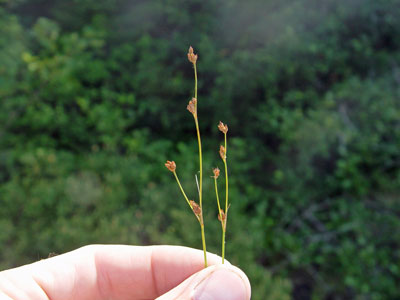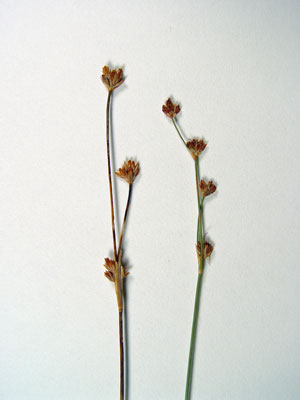DACF Home → Bureaus & Programs → Maine Natural Areas Program → Communities, Plants, and Animals → Rare Plants → Juncus alpinoarticulatus
Juncus alpinoarticulatus Chaix ex Vill. ssp. americanus (Farw.) Hämet-Ahti

Alpine Rush
- State Rank: S3
- Global Rank: G5T5
- State Status: Special Concern
Habitat: Wet shores, marshes. [Non-tidal rivershore (non-forested, seasonally wet)]
Range: Circumboreal, south in United States to Pennsylvania, Indiana, and Missouri.
Aids to Identification: Rushes are recognized by their grass-like morphology, small flowers with 6 inconspicuous sepals and petals (called tepals) and 3-valved capsules. Juncus alpinarticulatus belongs to a group of rushes that possess terete leaves (circular in cross-section) with transverse septae and flowers borne in dense clusters. There are several common species that resemble J. alpinoarticulatus, however, the combination of seeds lacking white appendages (visible with a 10x handlens) and upright branches of the inflorescence will separate this rush from those species.

Ecological characteristics: In Maine, alpine rush is restricted to rivershores where it usually grows in wet spots among cobbles on the lower portion of the rivershore.
Phenology: Flowers August to October.
Family: Juncaceae
Synonyms: Juncus alpinoarticulatus Chaix ex Vill. ssp. nodulosus (Wahlenb.) Hämet-Ahti, sensu American authors; Juncus alpinus Vill. var. americanus Farw.; Juncus alpinus Vill. var. rariflorus Hartman, sensu American authors.
Known Distribution in Maine: This rare plant has been documented from a total of 26 town(s) in the following county(ies): Aroostook, Kennebec, Lincoln, Sagadahoc, Somerset.
Reason(s) for rarity: At southern limit of range. Habitat naturally scarce.
Conservation considerations: Maintain hydrologic integrity of its rivershore habitat, including the natural disturbance.